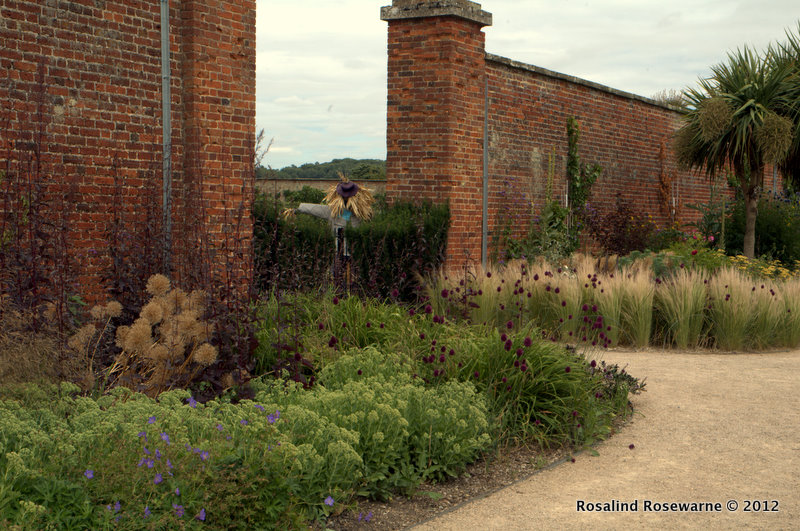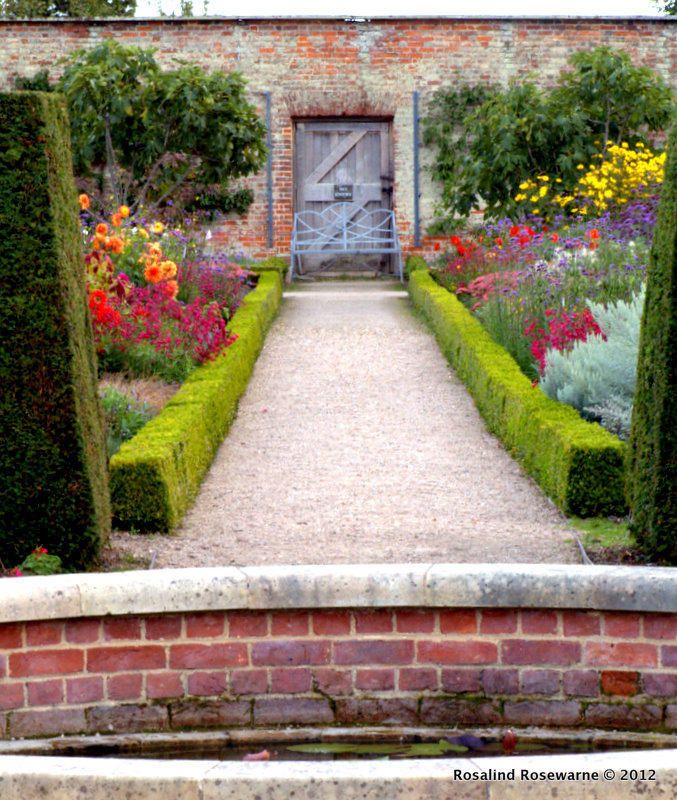I know I have banged on about Wimpole Hall on several occasions, it is my ‘local’ NT garden after all but it remains an inspiring place to go and is full of ideas to take home and try out, on a somewhat smaller scale of course!.

When I say it is inspiring I am not really talking of the parterre, which is best glanced at through dark glasses. Suffice to say it is a painful homage to bygone trends though may inspire budding Britain in Bloom entrants I suppose.
Making a right on the path to avoid the garish parterre one finds oneself ambling through a rather new woodland area that seems loaded with interesting specimen trees it’s difficult not to get distracted by the unusual selection and find it takes a long while to walk a short way.
Being determine though and knowing where I am headed I resist the urge and head decisively towards the Walled Garden. In fact it is a double walled garden.

The first gated entry, tucked into deep evergreen plantings, leads into a well stocked, expansive orchard.

A well designed path encourages me to move to the inner gardens but it’s tempting to wander in the orchard admiring the uncommon fruit varieties and wondering if anyone would miss a juicy applethat it calling my name. The long meadow grass lies briefly as hay beneath the trees, a gardener tells me it will be collected once dry. It’s evocative of a rural idyll of the past and somehow pleasing. He also tells me of the new beehives installed at one end of the orchard.

It’s not difficult to see how much the bees enjoy the enormous late summer borders that flank the outside of the inner walls. Wide flanks of abundant planting humming with insects.

That said I will say that they seemed to be far more interested in inhabiting a hole in the tall red brick wall a few feet up from the nectar rich border than flying hundreds of yards away to brand spanking new purpose built wooden boxes.

I can readily understand that desire.

The inner wall gate states that rabbits are unwelcome and one can imagine Peter, Flopsy, Mopsy and Cotton Tail would have a field day in the productive gardens that lie beyond.

Then there are choices to be made, ahead, left or right. Ahead one is greeted by a large greenhouse which is literally green and surrounded by a plethora of seasonal plantings both tender and hardy you can’t enter it but you can admire the gourds within.


To the right are blocks and blocks of flowers with enormous wooden labels identifying each variety. Though you have to know your genus and species as these are not well documented.
Leading around the gardens hedges of Gaura froth over the path

and walls of ripening fruit line the inner, inner walls.

Espalier, cordon and fan training all in evidence.
To the left the productive gardens are showing off

and alongside education material incorporated into borders. I didn’t know I could grow Woad (Isatis tinctoria)

still and am seriously considering a spot for it in the garden, though painting my face with it may not be on the list of things to use it for.
Though the walled garden is clearly used for educational purposes what stays with me the most is the idea that cut flowers can also be grown like a crop.

Long blocks of them are dotted through the big cultivated areas.

Echinacea, Crocosmia, Lavender, Iris and lots and lots of Dhalia.

There is something pleasing about order in a productive garden, everything has a place and an order presides. The design is formal and symmetrical as are many productive plots, this one speaks of borders designed to enhance views as well as accommodate ‘crops’ .

On every visit I come away with more ideas and plans than can possibly be put into a 30x10ft town garden and that is the joy of it, always something new to try next year. This year though I have an 80x12ft allotment to play with. Last years dahlia crop, grown from 3 packets of seed, in large garden pots is going in the ground once the frosts pass. It won’t be Wimpole but it will be fabulous all the same.

